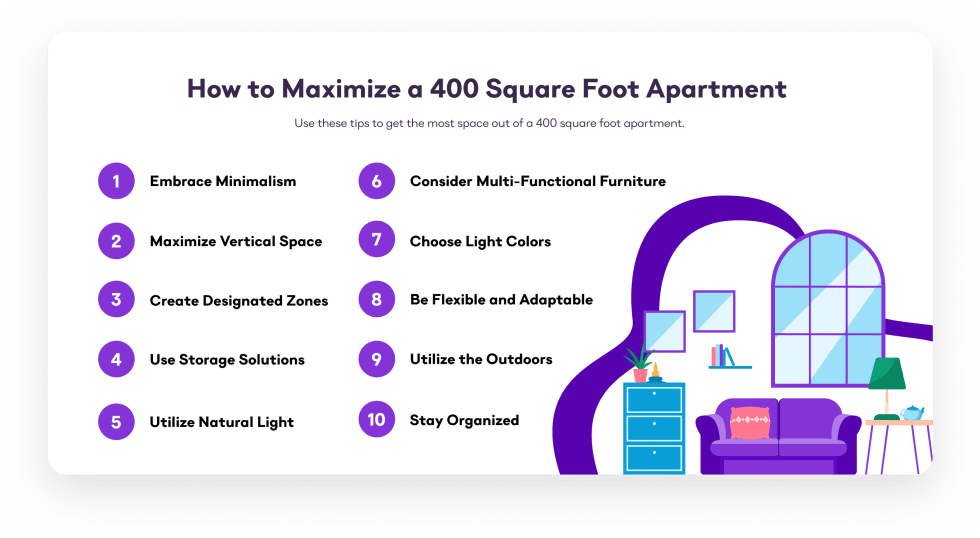South Bank at Quarry Trails
- 91 units available
- Studio • 1 bed • 2 bed • 3 bed
- Amenities
In unit laundry, Patio / balcony, Granite counters, Pet friendly, Stainless steel, Walk in closets + more

A 400 square foot apartment is a typical studio size, with enough room for a combined living and sleeping area, a bathroom, and a simple kitchen. If your lifestyle leans minimalist—or you’re hoping to cut down on rent, furniture, and all those apartment must-haves—a 400 square foot apartment might be the perfect size for you.
Plus, with a few design tricks, you can make the place feel way bigger than it is. So, if you’re wondering how big 400 square feet is, this guide covers everything you need to know to make the most of a small space.
You could ask your landlord how big your apartment is, but it doesn’t hurt to measure it yourself. Besides, knowing how to measure your apartment will come in handy when you’re ready to decorate and furnish the place.
Ready to get started? Grab a 100-foot tape measure, a pen, paper, and a calculator, and follow these simple steps:
Nice work! Now you’ve got the math down, and a clearer picture of what you’re working with.

A 400 square foot apartment looks about the same size as a two-car garage example, or an oversized bedroom. While it’s not a luxurious amount of space, an apartment of this size is functional and cozy.
Smaller, 400 square foot studio floor plans and micro-apartments are more common in urban areas like New York City or Washington, DC, as opposed to suburban areas.

Yes, a 400 square foot apartment is definitely livable. With the right layout and a little creativity, you’ll have space for all the essentials: a spot to sleep, cook, and relax.
The secret to small-space living? Organization and a little imagination. Here are 10 ways to make it work (and totally love it):
In a small apartment, every bit of square footage matters. Furniture is going to be your biggest necessity—literally and figuratively—so consider investing in multifunctional pieces. Think: an ottoman that doubles as storage, or a futon that doubles as a guest bed. It’s all about getting more with less.
A 400 square foot apartment will quickly show you what’s worth keeping, and what’s not. Try embracing minimalism and aim for items that serve a purpose, not just fill a corner. The less clutter you have, the more space you’ll actually feel.
Floor space might be limited, but vertical space is yours to get creative with. Floating shelves, wall hooks, and racks can hold everything from cookware to jackets. Even small tricks—like an over-the-door shoe organizer—can free up valuable square footage.
When your living, dining, and sleeping spaces all share one room, it helps to create “zones” that give your apartment structure. You can use rugs, bookcases, or lightweight screens to visually break up the space and create designated zones. For example, a bold rug under your bed can define your “bedroom,” while a small dining nook could live by the window.
Closets in small apartments are often limited—or missing altogether. That’s where smart storage comes in. Under-bed bins are lifesavers for off-season clothes. A rolling rack can hold jackets or everyday outfits. Over-the-door organizers are perfect for toiletries, cleaning supplies, or even snacks in a small kitchen. The goal is simple: everything should have a home, even if it’s hidden.
In a smaller space, lighting can make all the difference. Skip the heavy curtains and get the most natural light possible with lightweight window treatments. Bonus: letting the sunlight in can warm up your apartment naturally and even save on utilities in winter. Hanging mirrors across the windows can also amplify the effects of natural light.
Color plays a huge role in how spacious your apartment feels. White, cream, pale gray, or soft beige walls keep things open and bright. If you crave bold color, try an accent wall or bring it in through smaller items like throw pillows, rugs, or artwork. This way, you keep the room feeling airy without sacrificing personality.
If your apartment also has a balcony or patio, don’t waste it. Even a tiny outdoor nook can function as extra square footage. Add foldable chairs and a small table for coffee mornings, or start a mini herb garden. If your landlord allows, a storage bench outside can double as seating and extra stash space. Suddenly, your 400 square feet just got bigger.
Small apartments get cluttered fast. The trick isn’t just having storage systems; it’s actually using them consistently. Make it a habit to return items to their spot, whether that’s a drawer, a basket, or under the bed. A 10-minute nightly tidy-up can keep your place from spiraling into chaos. When everything has a home, the whole apartment feels calmer and more spacious.
Living small requires adaptability. You might rearrange furniture multiple times before you find the perfect setup. Stay open to change—your needs will shift, and your apartment can evolve with you. Flexibility is your best tool for making a small space work long-term.

Now that you know the answer to the question "how big is 400 square feet," you can get to work planning your space. You might even find you didn't need as much space as you thought, leaving more room in your budget each month.
Ready to find a small, cozy apartment of your own? Take Apartment List’s personalized quiz to get started. Whether you want something a little bigger or a micro 200-square-foot studio, you’ll find your perfect place, fast, fast. With us, you’ll spend 5 minutes and save 50 hours searching.
A queen-size bed usually fits in a 400 square foot apartment, but it’ll take up a good chunk of space. If you want more floor space during the day, consider a Murphy bed or loft bed to maximize the square footage you do have.
Yes, but it requires teamwork and compromise. Two people sharing this size apartment need to be intentional about furniture, storage, and personal space. It can work best for couples who don’t mind cozy living or roommates who mostly use the apartment as a crash pad.
The key is to start with a simple foundation and add just a few accents. Light-colored walls, neutral furniture, and streamlined storage keep things from feeling heavy. Then you can layer in personality with art, pillows, or plants—without tipping into clutter.
Most of the time, yes. Many tiny homes range from 150 to 300 square feet, so a 400 square foot apartment actually gives you a bit more room. However, the layouts are very different. Tiny homes often prioritize built-in storage, while city apartments usually require you to create your own solutions.
It all depends on location. In major cities like New York or San Francisco, 400 square feet can be pricey because every square foot is in demand. But in smaller cities or suburban areas, you may find the same size apartment for a fraction of the price.
Some do, but they’re often on the smaller side. Many renters in studios rely on rolling racks, under-bed bins, or wall shelving to supplement closet space. If storage is a priority, check the floor plan closely before you sign the lease.
Natural light, multifunctional furniture, and keeping it clutter-free daily all go a long way. Use mirrors to reflect light, choose lighter paint colors, and stick to decor that doesn’t overwhelm the room. Small design choices add up, and together they can make a studio feel more open.



In unit laundry, Patio / balcony, Granite counters, Pet friendly, Stainless steel, Walk in closets + more
In unit laundry, Hardwood floors, Dishwasher, 24hr maintenance, Stainless steel, Walk in closets + more